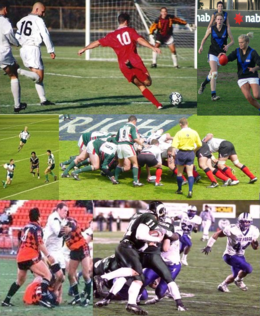FIFA WORLD CUP (RUSSIA)

What is literal meaning of term 'football'?
Any of various forms of team game involving kicking (and in some cases also handling) a ball, in particular (UK) soccer or (in the US) American football.

This article is about the overall concept of games called football. For specific versions of the game, the balls themselves and other uses of the term, see Football (disambiguation).

Several codes of football. Images, from top to down, left to right: association football (soccer), Australian rules football, international rules football, a rugby union scrum, rugby league, and American football.
- Football is a family of team sports that involve, to varying degrees, kicking a ball with a foot to score a goal. Unqualified, the word football is understood to refer to whichever form of football is the most popular in the regional context in which the word appears. Sports commonly called football in certain places include: association football (known as soccer in some countries); gridiron football (specifically American football or Canadian football); Australian rules football; rugby football (either rugby league or rugby union); and Gaelic football.[1][2] These different variations of football are known as football codes.
Various forms of football can be identified in history, often as popular peasant games. Contemporary codes of football can be traced back to the codification of these games at English public schools during the nineteenth century.
The expanse of the British Empire allowed these rules of football to spread to areas of British influence outside the directly controlled Empire.
By the end of the nineteenth century, distinct regional codes were already developing: Gaelic football, for example, deliberately incorporated the rules of local traditional football games in order to maintain their heritage.
In 1888, The Football League was founded in England, becoming the first of many professional football competitions. During the twentieth century, several of the various kinds of football grew to become some of the most popular team sports in the world.
Commom elements

The various codes of football share certain common elements: Players in American football, Canadian football, rugby union and rugby league take up positions in a limited area of the field at the start of the game.
They tend to use throwing and running as the main ways of moving the ball, and only kick on certain limited occasions. Body tackling is a major skill, and games typically involve short passages of play of 5–90 seconds.Association football and Gaelic football tend to use kicking to move the ball around the pitch, with handling more limited. Body tackles are less central to the game, and players are freer to move around the field (offside laws are typically less strict).
Common rules among the sports include:[
- Two teams of usually between 11 and 18 players; some variations that have fewer players (five or more per team) are also popular.
A clearly defined area in which to play the game.
Scoring goals or points by moving the ball to an opposing team's end of the field and either into a goal area, or over a line.
Goals or points resulting from players putting the ball between two goalposts.
The goal or line being defended by the opposing team.Players being required to move the ball—depending on the code—by kicking, carrying, or hand-passing the ball.
Players using only their body to move the ball.
In all codes, common skills include passing, tackling, evasion of tackles, catching and kicking.In most codes, there are rules restricting the movement of players offside, and players scoring a goal must put the ball either under or over a crossbar between the goalposts.